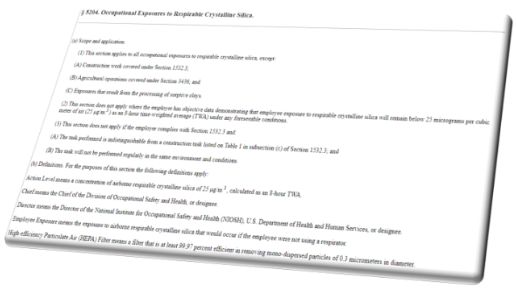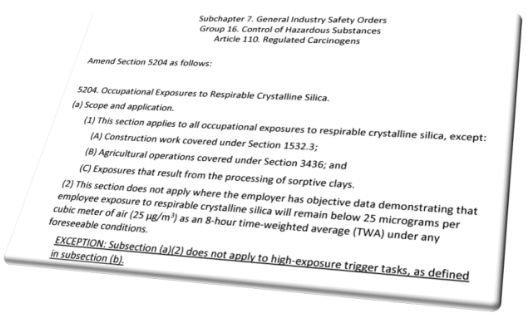The increasing use of "manufactured" or artificial stone to make countertops has resulted in an alarming increase in silicosis among workers. The problem is so severe that some jurisdictions, such as Australia, have outlawed the creation or importation of manufactured stone altogether.
Manufactured stone is created by pulverizing crystalline silica stone such as marble and granite into powder, bonding it with resins, and then cutting and sanding it into a desired shape. The process creates dust particles much finer than ordinarily occur traditionally from work with marble and granite, and thus are more damaging when inhaled.
Earlier this year a worker advocacy group filed a petition with the Standards Board (Board) to adopt an Emergency Temporary Regulation (ETS) to address the hazard, arguing that the current regulation addressing respirable crystalline silicosis is not effective against this new aggressive form of the disease. While a recent study by Cal/OSHA found that 70% of stone fabrication companies were not following the requirements of the existing regulation, industry representatives stress that they are compliant. The problem is that a large number of new, small fabricators are not. They assert a failure by these "bad actors" to follow the existing standard and Cal/OSHA's failure to enforce existing regulations, is causing the rise in silicosis cases.
As we saw with the COVID-19 ETS, early in the review process the Standard Board's staff concluded that no new mandate was needed to protect workers and recommended that the petition be denied. The Board, however, disagreed and tasked Cal/OSHA with drafting the ETS.
This ETS marks a departure from previous ETS's, such as the COVID-19 ETS, in that it is not a wholly new regulation, but rather an update of an existing regulation. Its scope is broad, including fabricators using traditional stone as well as those working with manufactured stone.
At the recent Standards Board hearing the public comment favoring the adoption of the ETS came from occupational health practitioners, doctors, worker and labor groups, and Cal/OSHA staff. Highlighted was evidence of the growing number of workers affected by the disease, the effects of which are irreversible. These comments overwhelmed requests from industry representatives that the proposed ETS be shelved so that they could effectively participate in the regular rulemaking process to draw clearer distinctions between traditional stone and manufactured stone. Adding new mandates on compliant employers, they said, will only hurt them while doing little to ensure that non-compliant fabricators come into compliance.
Cal/OSHA Deputy Chief Eric Berg objected to any delay in approving the ETS, stating that waiting will likely mean that the draft ETS would not come before the Board again until next March. This was compounded by Board chair Dave Thomas's comment that in light of the Board's Executive Officer departure, it will be difficult to get much done in 2024.
Berg further described the current regulation as inadequate in large part because it places the burden on the Division to prove exposure through time-consuming air monitoring. The newly-adopted ETS – ( Occupational Exposures to Respirable Crystalline Silica Emergency -Proposed Text) – shifts that burden to employers by presuming exposure from specified tasks. Employers will now need to prove the absence of the hazard in their workplaces.
Some highlights of the new regulation include:
- Revising Section 5204 to include "[h]igh-exposure trigger tasks ... regardless of employee exposures, exposure assessments, or objective data."
- Defining "high-exposure trigger task" to include machining, crushing, cutting, drilling, abrading, abrasive blasting, grinding, chipping, chiseling, carving, gouging, polishing, buffing, fracturing, or breaking artificial stone that contains more than 0.1% crystalline silica, or for natural stone that has more than 10% percent by weight crystalline silica. High-exposure trigger tasks also includes cleaning up, disturbing, or handling of wastes, dusts, residues, debris, or other materials created during the above-listed tasks.
- Adding a requirement that, for employees who are reasonably expected to be exposed to respirable crystalline Silica, continued monitoring cannot be discontinued and should be "repeated at least every 12 months or more frequently" if required.
- Adding a requirement that all "high-exposure trigger tasks ... be conducted within a regulated area regardless of employee exposures, exposure assessments, or other objective data." Employers were already required to establish a regulated area wherever an employee's exposure to airborne concentrations of respirable crystalline Silica is, or can reasonably be expected to be, over the PEL. That area would be demarcated from the rest of the workplace to minimize the number of employees exposed to respirable crystalline Silica.
- Requiring engineering controls and work practice controls
(housekeeping) for all high-exposure trigger tasks, regardless of
employee exposures, exposure assessments, or objective data. The
mandatory engineering controls will include the use of effective
wet methods. In addition, employers, will be required to perform
the following housekeeping tasks:
- Prompt and proper cleanup of "[w]astes, dusts, residues, debris, or other materials that are generated from high-exposure trigger tasks ... and [placement] into leak-tight containers, bags, or equivalent";
- Use of wet methods or vacuum cleaners equipped with HEPA filters to collect all wastes, dusts, residues, debris, or other materials that are generated from high-exposure trigger tasks or that otherwise contain or are contaminated with respirate crystalline silica;
- Use of respirator protection; and
- To Provide readily accessible washing facilities.
- Requiring that written exposure control plans (in workplaces
where high-exposure trigger tasks occur) contain:
- A description of the tasks in the workplace that involve exposure to respirable crystalline silica;
- A description of the engineering controls, work practices, and respiratory protection used to limit employee exposure to respirable crystalline silica for each task; and
- A description of the housekeeping measures used to limit employee exposure to respirable crystalline silica.
- Requiring California employers whose employees handle carcinogenic substances file written reports of use with the chief of DOSH, as required by General Industry Safety Orders (GISO) Section 5203 in certain instances. Reports would be for:
- All regulated carcinogens that require an employer to establish a regulated area.
- Regulated carcinogens that do not have a regulated area requirement, for any use of concentration greater than 0.1 percent by weight or volume that results in an exposure or potential exposure to employees.
- Requiring employers to provide either a "full face, tight-fitting powered air-purifying respirator (PAPR) equipped with a HEPA filter and organic vapor cartridge" or a "full face, tight-fitting supplied air respirator in pressure-demand or other positive pressure mode" for employees performing high-exposure trigger tasks or working within the regulated area.
- Requiring employers provide medical examinations to all employees who will be occupationally exposed to respirable silica at or above the action level for 30 or more days per year both (1) initially and (2) at least every three years thereafter.
- Requiring employers train employees on: the health hazards and symptoms of respirable crystalline; the workplace tasks that might cause exposure; what measures their employer has implemented to prevent employee exposure; how to properly use and implement engineering controls, work practices, and respiratory protection; the purpose and description of the medical surveillance program; the increased risk of death that results from the combined effects of smoking and respirable crystalline silica exposure; and the increased risk of a latent tuberculosis infection becoming active that results from the effects of respirable crystalline silica exposure.
The ETS will become effective December 24, 2023 and will last six months. Berg said that the Division has already created a special emphasis program addressing the issue and is now ready to start enforcing the ETS when it becomes effective.
If no permanent language incorporating these changes into 8 CCR § 5204 is approved within six months, the Board can vote to extend the ETS for another six months.
Board member Kate Crawford, who represents management, noted that no one disputes that manufactured stone poses a grave risk to worker health. As always, the devil is in the details. Presumably the concerns raised by industry representatives can be addressed during the drafting of the permanent regulation, but any substantive changes to the new provisions in the ETS are unlikely.
In the meantime, this ETS affects all employers who work with traditional stone as well as manufactured stone in California. Now is the time to review the new regulation and make the changes needed to be compliant. We are working on draft language to amend our clients' safety and health procedures to meet this challenge. Please call or email our Cal/OSHA team to ask questions or request assistance.
The content of this article is intended to provide a general guide to the subject matter. Specialist advice should be sought about your specific circumstances.







